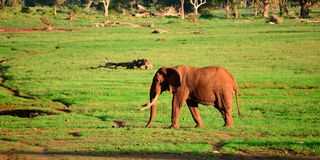The raging war between red elephants of Tsavo and man

An elephant roams in Taita Hills conservancy. Tsavo National Park hosts the rare red dusted elephants, which earn their name from the fine red volcanic soil that blankets the landscape, which they spray onto themselves to keep cool.
What you need to know:
- These rare red dusted Elephants criss-cross between the protected Tsavo National Park and surrounding areas.
- But this is a shrinking landscape and the fight for space and resources is intensifying, sometimes leading to deadly consequences.
One of the country's hotspots for human-wildlife conflict is Taita Taveta. Communities depend on the land for farming to sustain their livelihoods, and the same land is inhabited by the county's mightiest residents—the iconic Red elephants. These rare red dusted Elephants criss-cross between the protected Tsavo National Park and surrounding areas. But this is a shrinking landscape and the fight for space and resources is intensifying, sometimes leading to deadly consequences.
The Climate Action team heads to Tsavo to find out how this delicate relationship is managed. It is one of Africa's most incredible landscapes and Kenya's oldest and largest national parks spanning 22,000 square kilometres.
A few minutes after arriving, we spot a herd. The red elephants are magnificent, earning their name from the fine red volcanic soil that blankets the landscape, which they generously spray onto themselves to keep cool. The soil embeds itself within the creases of their thick, grey skin, leaving the elephants stained and red.
Elephants are water-dependent animals and currently, the commodity is abundant, thanks to the ongoing rains. But it's not always like this. In Tsavo, life is defined by rains, and when the rains fail, life becomes harder — and the journey to areas with staple food and water supplies begins. But something is standing in the way of these gentle giants. Alfred Mwanake, the CEO of Taita Taveta Wildlife Conservancies Association, says elephants need space and connectivity.
"Voi was a small town but over the years, it has expanded. Land has to be subdivided and historic dispersal areas have now become settlement areas. This has given birth to the human-wildlife conflict," he says.
Elephants are incredible species — intelligent, empathetic and protective. But to many people who live in close proximity with the jumbos, they are a nuisance.
At the foot of Taita Hills is Teri B location in Mgeno, about 20 kilometres from Tsavo East National Park. The community here is made up of farmers. Anderson Keke has lived here for the last 15 years. He says this harvesting season, his farm has been invaded by elephants three times.
"I have cultivated about four acres, but I only harvested from one acre. The rest has been destroyed by elephants. This is the maternity region for elephants. They pass through my farm and damage crops and plastic water tanks. If they come past people, they terrorise them. I feel hopeless".
These elephants are simply on a quest to quench their thirst and fill their stomachs. Due to their poor digestion, the oversized mammals require extraordinary quantities of food to survive—almost 150 kilos a day—and will cross all boundaries to get what they need.
Wabosha Kamattah, a resident and a Community Land Management Committee member in Teri B, knows this all too well. Her home was raided and damaged by elephants, putting her at a financial loss.
Sixty five per cent of elephants reside in community areas. In 2017, a bold step was taken – turning land owned by communities, which forms critical wildlife dispersal areas, into conservancies led by the Taita Taveta Wildlife Conservancy Association. Mgeno, situated close to the park, transitioned from a livestock ranch to a conservancy.
Cecil Peter, the manager, says they decided to maximise the use of the 53,000 acres and because Mgeno is endowed with wildlife, they wanted to participate in active conservation of various species while generating income through conservation programmes.
However, Wabosha says the impact is not being felt: "We can co-exist, but first, we need to see the benefits of conservancies and tourism coming directly to the person on the ground. Because that is what is not happening."
Kasigau is located between the Tsavos and shares a boundary with Tsavo West National Park. It is another area notorious for human-wildlife conflict. In 2021, Kasigau transitioned into a conservancy to protect both wildlife and people.
A group of women who were traditionally farmers have been forced to look for an alternative source of livelihood after marauding elephants destroyed their farms. They have embarked on a basket weaving business, but they are yet to reap benefits as they don't have a market. It is a love-hate relationship between the community and the elephants that have disrupted what was their primary source of income.
Alfred acknowledges the challenge: "The most important thing is that the economic benefits that come with conservancies have to be balanced with that. For us to ensure communities in the present and the future can continue to sustain the conservancy model, resources must be invested so we can equate conservation to economic benefits to the community."
The Nature Conservancy (TNC) is a key partner that supports the ecosystem. Jack Marubu, the community engagement specialist, says TNC is supporting the conservancy model by building policies, systems, and structures as well as complementing the government's efforts. He says it's an important project to invest in to create homegrown solutions for the challenges being experienced and that an inclusive approach is critical.
"Communities are the greatest investors within any conservation arrangement, so they must be the greatest beneficiaries." He adds: "Building the capacity of communities to manage wildlife on their own and creating commensurate benefits to the whole conservation arrangement will not only create more tolerance but also increase wildlife numbers in these areas because conflicts have led to the animal mortalities we see around."
[email protected] NTV Wild Talk's "Red Elephants of Tsavo" episode tonight on NTV Kenya or on ntvkenya.co.ke at 8.25pm


